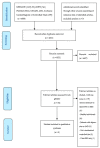The Effect of Light Therapy on Electroencephalographic Sleep in Sleep and Circadian Rhythm Disorders: A Scoping Review
- PMID: 35997384
- PMCID: PMC9397048
- DOI: 10.3390/clockssleep4030030
The Effect of Light Therapy on Electroencephalographic Sleep in Sleep and Circadian Rhythm Disorders: A Scoping Review
Abstract
Light therapy is used to treat sleep and circadian rhythm disorders, yet there are limited studies on whether light therapy impacts electroencephalographic (EEG) activity during sleep. Therefore, we aimed to provide an overview of research studies that examined the effects of light therapy on sleep macro- and micro-architecture in populations with sleep and circadian rhythm disorders. We searched for randomized controlled trials that used light therapy and included EEG sleep measures using MEDLINE, PubMed, CINAHL, PsycINFO and Cochrane Central Register of Controlled Trials databases. Five articles met the inclusion criteria of patients with either insomnia or delayed sleep−wake phase disorder (DSWPD). These trials reported sleep macro-architecture outcomes using EEG or polysomnography. Three insomnia trials showed no effect of the timing or intensity of light therapy on total sleep time, wake after sleep onset, sleep efficiency and sleep stage duration compared to controls. Only one insomnia trial reported significantly higher sleep efficiency after evening light therapy (>4000 lx between 21:00−23:00 h) compared with afternoon light therapy (>4000 lx between 15:00−17:00 h). In the only DSWPD trial, six multiple sleep latency tests were conducted across the day (09:00 and 19:00 h) and bright light (2500 lx) significantly lengthened sleep latency in the morning (09:00 and 11:00 h) compared to control light (300 lx). None of the five trials reported any sleep micro-architecture measures. Overall, there was limited research about the effect of light therapy on EEG sleep measures, and studies were confined to patients with insomnia and DSWPD only. More research is needed to better understand whether lighting interventions in clinical populations affect sleep macro- and micro-architecture and objective sleep timing and quality.
Keywords: circadian rhythm disorder; electroencephalography; insomnia; light therapy; quantitative EEG analysis; sleep disorder.
Conflict of interest statement
The authors declared no conflict of interest.
Figures
Similar articles
-
Circadian tau differences and rhythm associations in delayed sleep-wake phase disorder and sighted non-24-hour sleep-wake rhythm disorder.Sleep. 2021 Jan 21;44(1):zsaa132. doi: 10.1093/sleep/zsaa132. Sleep. 2021. PMID: 32619243
-
Effects of cognitive behavioural therapy and bright light therapy for insomnia in youths with eveningness: study protocol for a randomised controlled trial.Trials. 2024 Apr 9;25(1):246. doi: 10.1186/s13063-024-08090-0. Trials. 2024. PMID: 38594725 Free PMC article.
-
Increased sensitivity of the circadian system to light in delayed sleep-wake phase disorder.J Physiol. 2018 Dec;596(24):6249-6261. doi: 10.1113/JP275917. Epub 2018 Oct 25. J Physiol. 2018. PMID: 30281150 Free PMC article.
-
Circadian aspects in the aetiology and pathophysiology of insomnia.J Sleep Res. 2023 Dec;32(6):e13976. doi: 10.1111/jsr.13976. Epub 2023 Aug 3. J Sleep Res. 2023. PMID: 37537965 Review.
-
Light therapy for the treatment of delayed sleep-wake phase disorder in adults: a systematic review.Sleep Sci. 2021 Apr-Jun;14(2):155-163. doi: 10.5935/1984-0063.20200074. Sleep Sci. 2021. PMID: 34381579 Free PMC article. Review.
Cited by
-
Rhythms under tension: Circadian clocks in an Unsynced Society.Biomed J. 2025 Jun;48(3):100873. doi: 10.1016/j.bj.2025.100873. Epub 2025 May 17. Biomed J. 2025. PMID: 40389157 Free PMC article.
-
The prognosis of patients with myocardial infarction after light therapy: A preliminary study.Biomed J. 2025 Jun;48(3):100783. doi: 10.1016/j.bj.2024.100783. Epub 2024 Aug 8. Biomed J. 2025. PMID: 39122187 Free PMC article. Clinical Trial.
References
-
- Wever R.A. Phase shifts of human circadian rhythms due to shifts of artificial zeitgebers. Chronobiologia. 1980;7:303–327. - PubMed
Publication types
LinkOut - more resources
Full Text Sources
Miscellaneous


